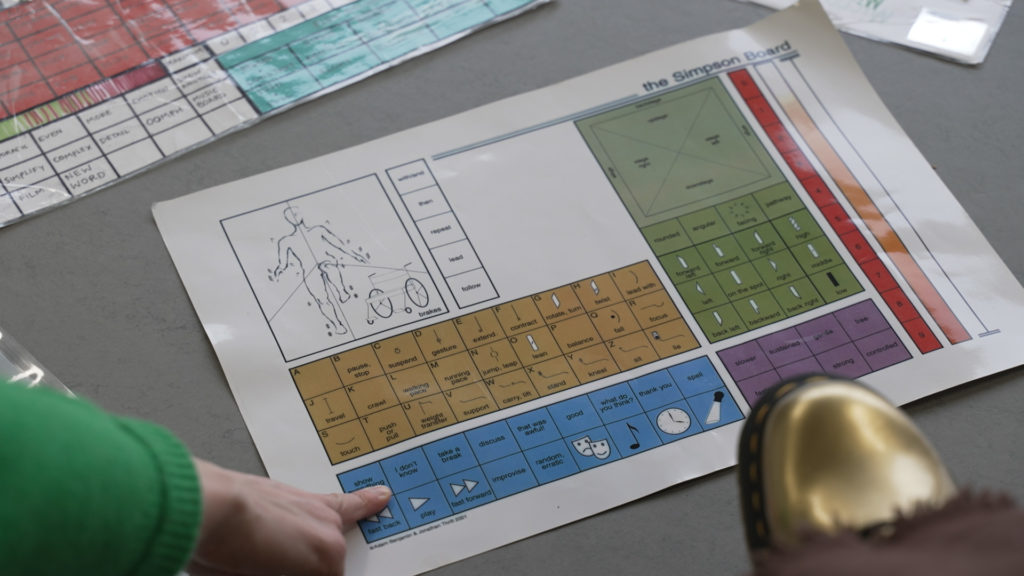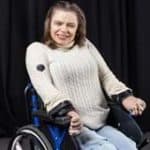Choreography is like designing with bodies
Lisa Simpson is a choreographer and the new artistic director for Sense and the National Inclusive Dance Programme. She explains how she uses a novel form of communication to choreograph dance pieces.
For me, choreography is designing with bodies on a stage. I’ve always had a passion for the arts and for creative work. As someone who has no control of their own four limbs, choreography allows me to fulfil my passion by portraying sequences of movement in others.
I was born with quadriplegia cerebral palsy and no verbal communication. I communicate by using a transparent letter board, which I look at to spell out words using my eyes. I also use Eye Gaze to access everything on the computer, operating it with a bar that detects my eye movements.
From pebbles to people
My journey into the dance sector has been unique and unconventional. When I was 12, I was invited to a dance event at the local mainstream school. This was the first time I found myself wishing I could dance on stage. I loved how everyone kept in time with each other, making it look easy and fun. But, deep down, I thought it wouldn’t ever be possible because of my disability.
So, instead, I decided to pursue a career in computers. I soon realised this just wasn’t for me – I hate paperwork! I managed to change and join a series of art-based courses – I loved it right from the start.
Things got even better when Adam Benjamin, co-founder and joint artistic director of the Candoco Dance Company, came to my college. He was inspired by the methods I used to produce visual artwork for my GCSE Art and Design, which involved me creating pieces with stones. I arranged each stone by looking at where I wanted it to be placed, indicating with my eyes and head which direction it needed to be moved in. Adam thought this could be done with bodies too.
Sculpting dances with my eyes
Together, Adam and I developed what’s come to be known as the Simpson Board – named after me! It’s this tool that enables me to choreograph.
The board is a flexible, A3-sized, laminated sheet covered in the words, diagrams and symbols needed to create a dance sequence. It enables the user to indicate with their eyes – or by pointing – where, on a virtual stage, they would like the dancers to be and what sort of moves they should make. These decisions are very precise.
An assistant sits alongside the user, reading the board and then speaking the instructions out loud to the dancers. If, for example, I want a dancer to move their left shoulder, I will look at the left shoulder on the diagram.

The first time I choreographed gave me such a tremendous feeling, like Adam had opened up another world for me.
In my work, I’m inspired by pattern, reflection, kaleidoscopic images and symmetry.
My new dream was to choreograph a piece and tour it all around the world.
In lockdown, I couldn’t use the Simpson Board because it requires a translator to be next to me. So, I came up with the idea of using numbers to represent different parts of the body to allow me to choreograph remotely. I call it the Body Board.
Sense have been a dream to work with
I first got involved with Sense in 2018 when Steph Tyrrell, head of the arts team, came up to see me in Liverpool. She asked me to devise a project for dancers who are deafblind.
When I was asked to get involved in a new National Inclusive Dance Programme, I was so flattered. The word ‘leader’ didn’t sit right with me, so we agreed I would be artistic director.
Working with Sense has been magical. My future ambition in this new role is to create a programme that’s accessible for all types of disabilities, including complex needs. I want it to be a sustainable model for other art forms to use. Many people with complex disabilities have not yet been given the opportunity to realise their creative potential.
I also want the programme to be the vehicle for emerging disabled artists who are keen to pursue a creative career.
The power of dance
Dance is a form of communication that gives me a way of expressing words through movement. It has physical and social benefits for disabled people, making everyday worries go away while growing people’s confidence and independence.
It’s also a powerful tool to combat loneliness and isolation. I’ve worked with someone with autism, who completely came out of their shell because of dance.
To those who want to dance I say, just to take a step at a time and be as creative as you want to be.
Get stories like this in your inbox
Get inspiring stories like Lisa’s in your inbox, alongside ways to get involved.

